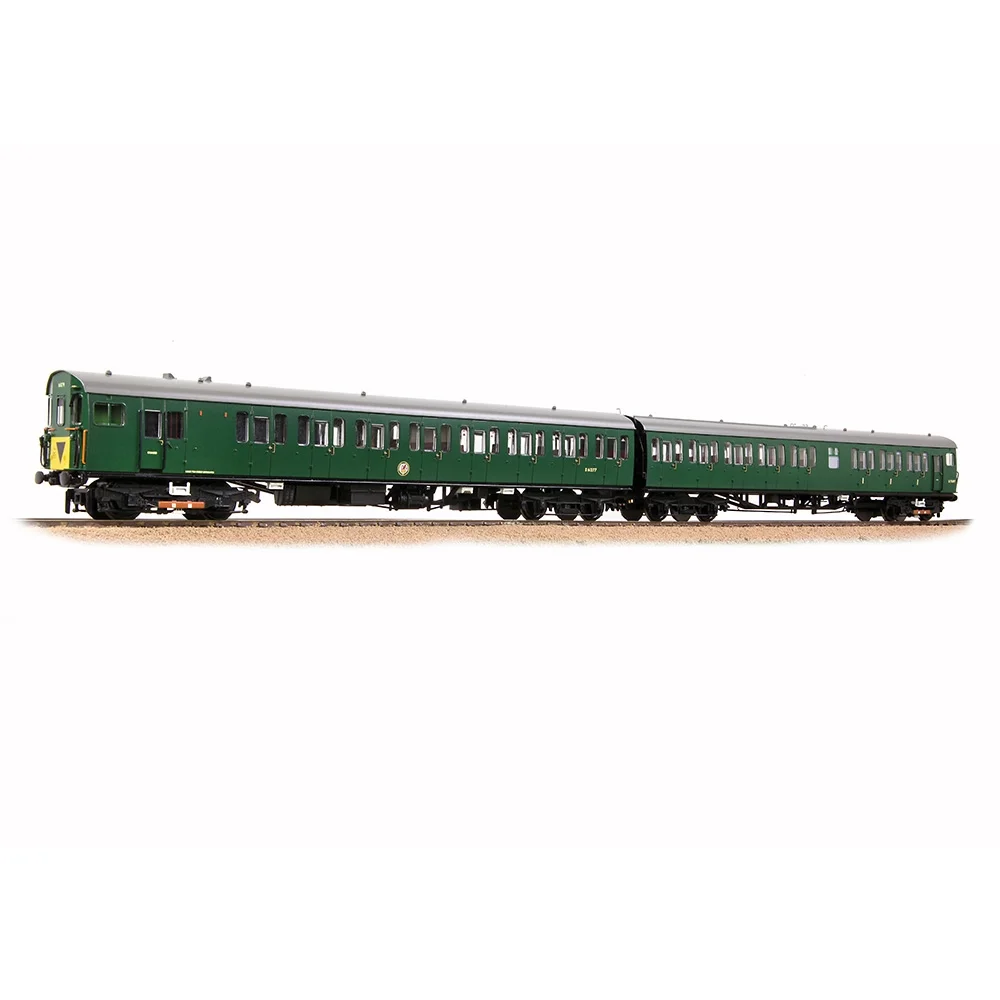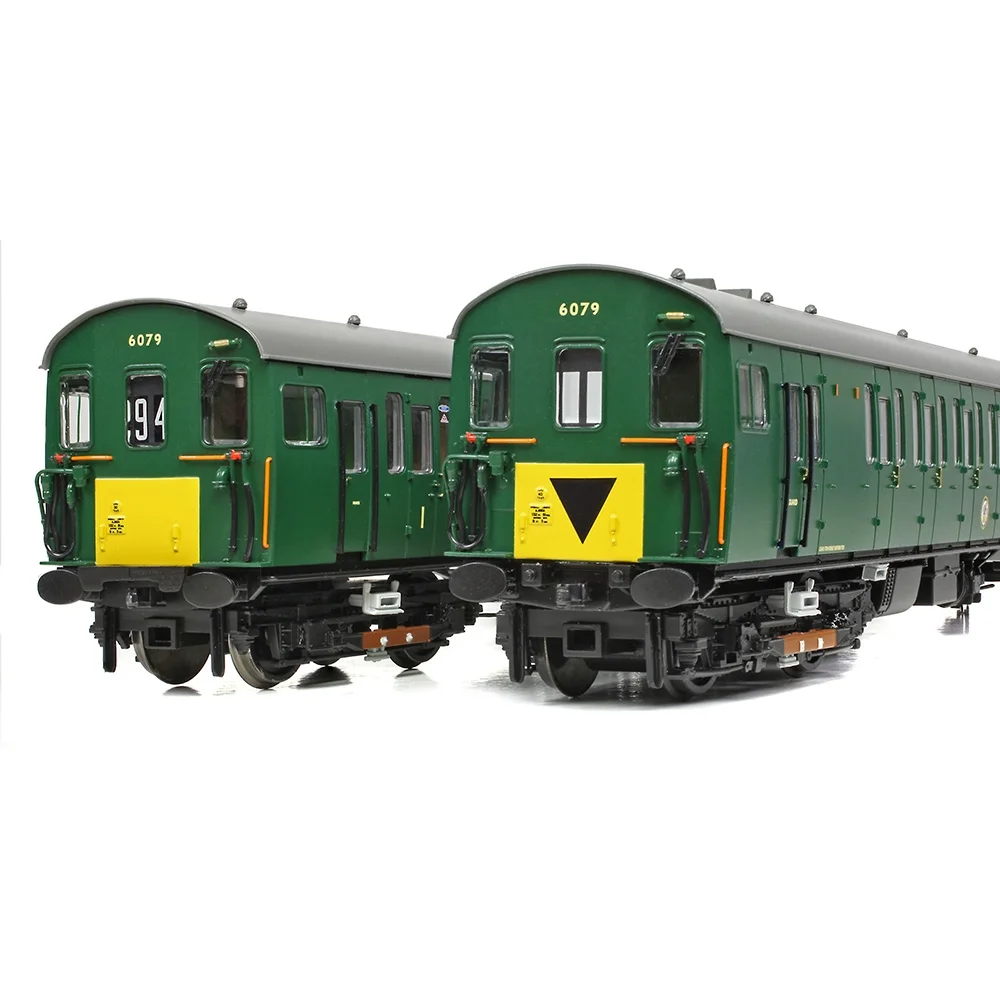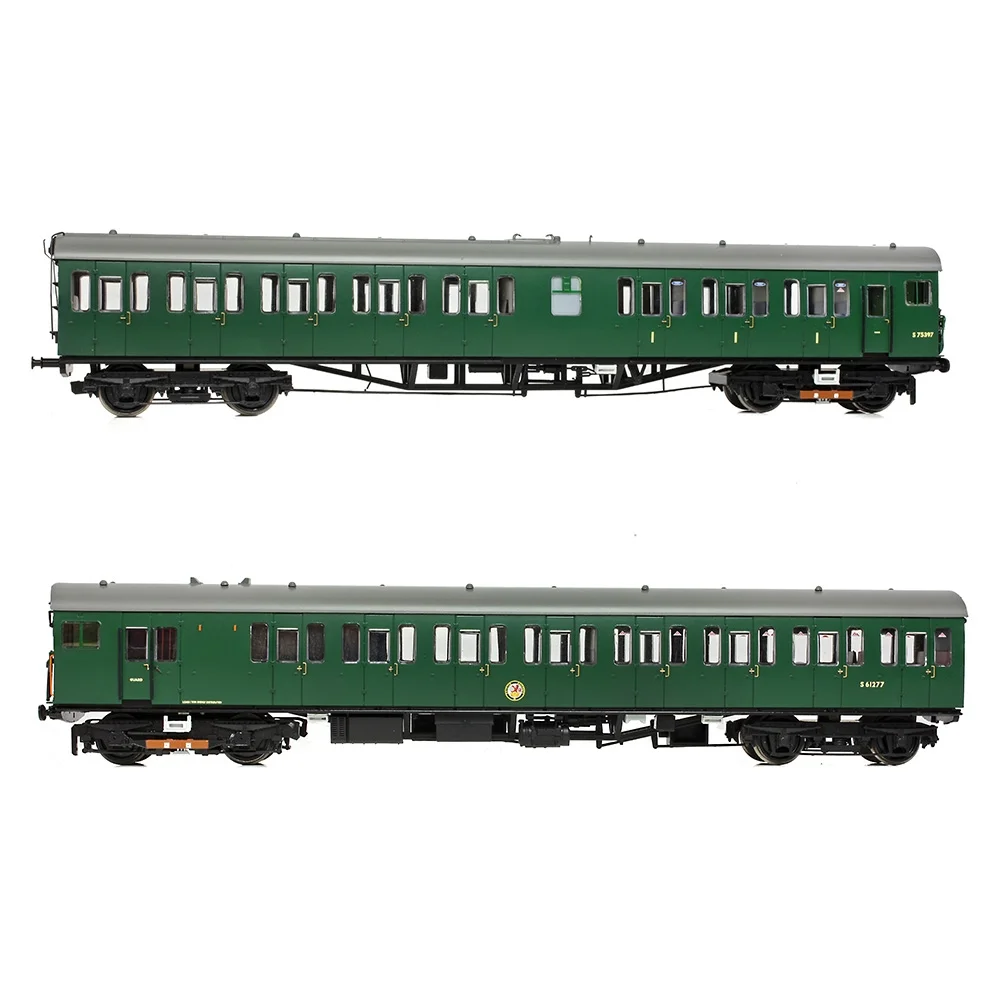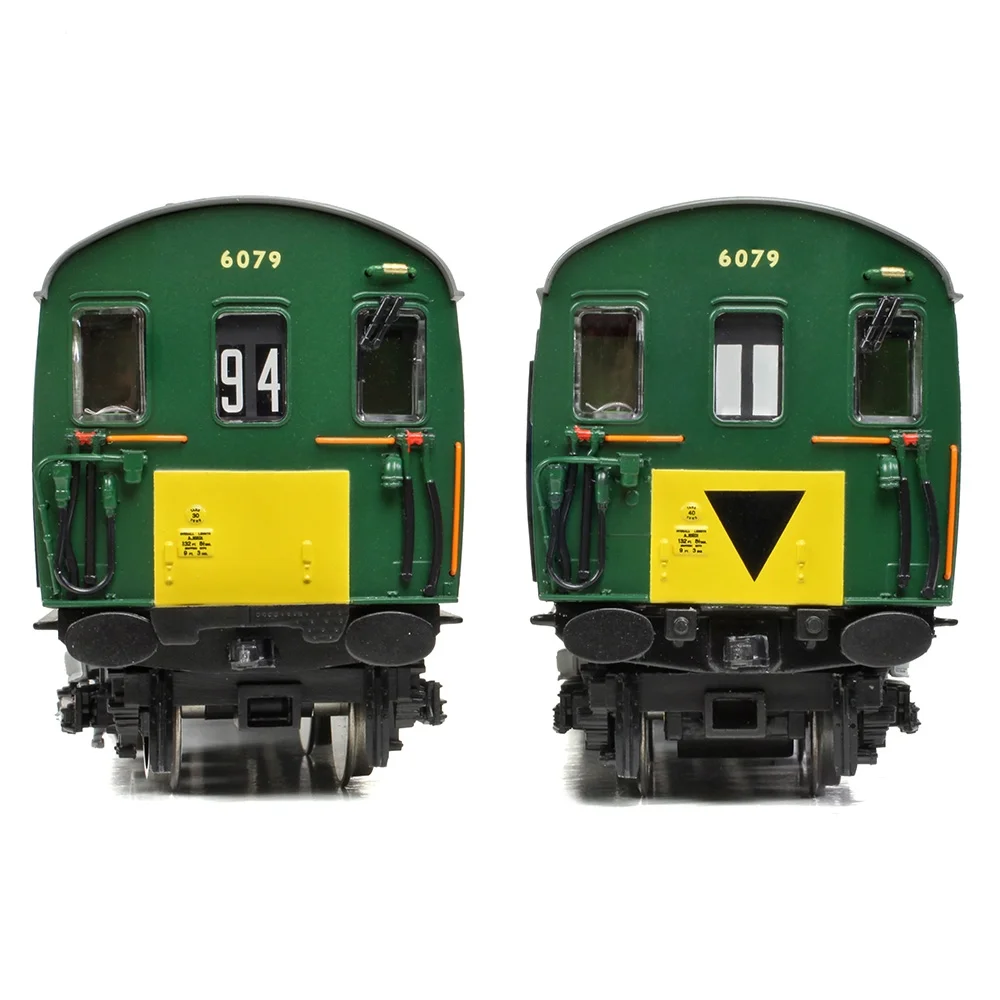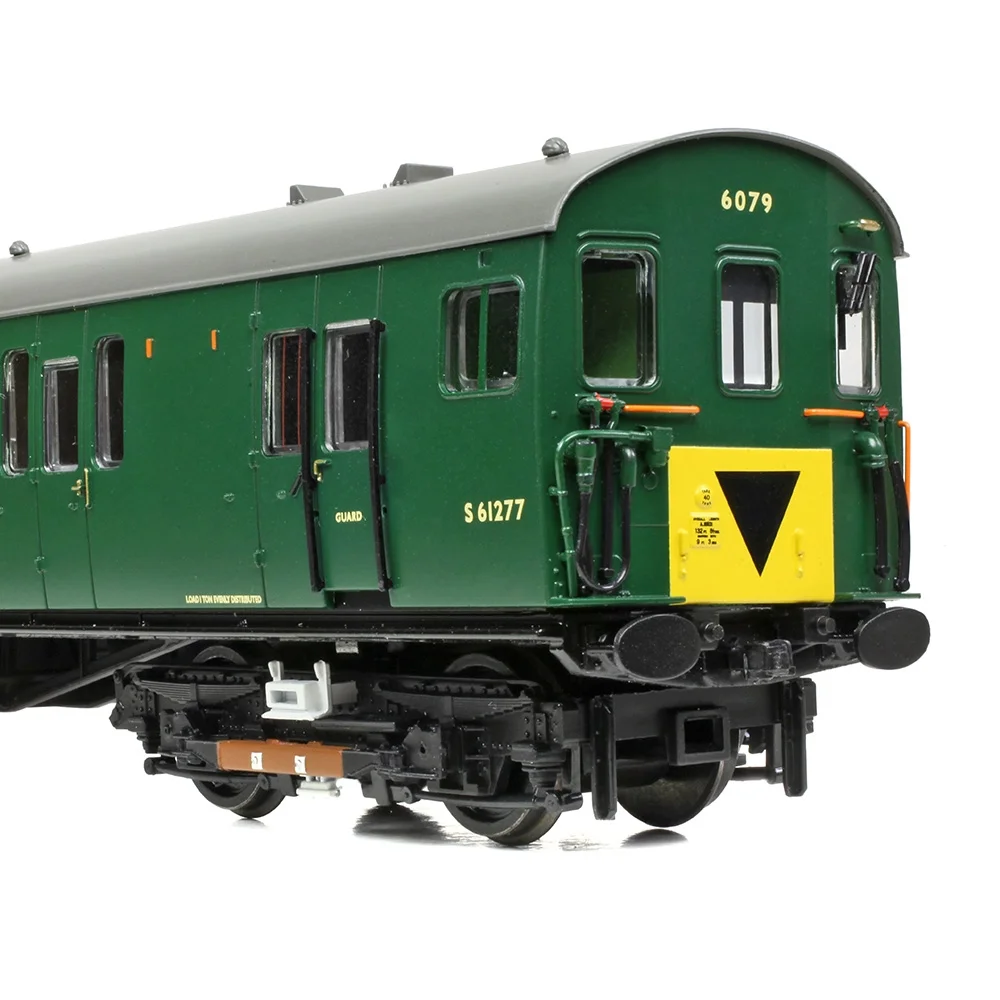Bachmann 31-393
British Rail Class 414 6079 British Railways Southern Region Green
Bachmann's Description & Specifications
Bachmann Branchline pioneered the production of Southern Third Rail Electric Multiple Units (EMUs) with the introduction of the 4CEP, the first contemporary OO Scale model of its type and since that seminal release, further first generation EMUs have joined the Branchline range. The 2-HAP (later Class 414) is the most recent introduction.
Like the real units, this 2-HAP comprises a Driving Motor Brake Second (DMBS) and a Driving Trailer Composite Lavatory (DTCL) and both vehicles are constructed from precision moulded bodyshells that are adorned with fine detail from the door handles, hinges and bumpers, to the steps at the inner ends. Metal wire handrails and filler pipes are also fitted to the inner ends, whilst the driving cabs are adorned with multiple working equipment, windscreen wipers and whistles above the driver’s window, all fitted separately. Guard’s periscopes feature on the roof of the DMBS too. Underneath each vehicle the truss frames and brake gear is depicted, along with a full set of auxiliary equipment and boxes. The flush glazed windows give a view of the internal seating which is made all the more visible thanks to the interior lighting, whilst the cab is fitted with a driver’s seat, control desk and brake wheel.
With conductive couplings employed between the two vehicles, mounted on close-coupling mechanisms, NEM coupling pockets are also fitted to the bogies at each end allowing multiple units to be coupled together. Each wheelset is fitted with electrical pickups and capacitors are used to provide back-up power preventing light flicker. Just a single 21 Pin decoder is required to use the model on DCC, or why not opt for a SOUND FITTED model which comes pre-fitted with a ESU Sound Decoder to provide authentic sound effects on DCC or Analogue Control straight out of the box.
We are delighted to present this stunning two car set in BR (SR) Green livery with Small Yellow Panels.
- Bachmann Branchline OO Scale
- Era 5
- Pristine BR (SR) Green (Small Yellow Panels) Livery
- Set No. 6079
- 2-Car Unit comprising DMBS No. S61277 and DTCL No. S75397
- NEM Coupling Pockets at the outer ends
- Integral conductive couplings mounted on close-coupling mechanisms between vehicles
- Accessory Pack - including Short & Long conductive couplings
- Powerful 5-pole motor driving the motor bogie fitted to the DMBS - just like the real units
- Interior Lighting including the Driving Cab
- Illuminated Headcode Blinds
- Ready to accept a Speaker
- Equipped with a 21 Pin DCC Decoder Socket - recommended Decoder 36-557A
- Length 532mm
Class & Prototype
- Class: British Rail Class 414
- Traction: Electric Multiple Unit
- Built: 1956-1963
- Total Built: 209
- Running Number: 6079
The BR Class 414, known as the "2HAP" (2-car Half lavatory electro-Pneumatic), were pioneering electric multiple units that served Southern Region from 1956-1995. Built at Eastleigh Works in four batches totalling 209 units, these elegant two-car EMUs featured Britain's first production electro-pneumatic braking system, enabling 90mph express operation and sophisticated multiple working capabilities.
Distinguished by their Mark 1 coach profiles and characteristic "slam-door" design, the Class 414 units provided dual-class accommodation with 19 first-class compartment seats and 134 second-class saloon seats, plus lavatory facilities. Powered by twin EE507 traction motors producing 1,250hp, they formed the backbone of Kent Coast electrification services, working everything from London-Dover expresses to rural branch shuttles.
The class adapted throughout its 39-year career, serving through BR green, blue/grey, and Network SouthEast liveries whilst maintaining exceptional reliability. Technical innovations including electro-pneumatic braking and advanced control systems influenced British EMU design for decades. Today, unit 4308 survives in preservation at the Science Museum, whilst excellent Bachmann OO gauge models in multiple liveries enable authentic recreation of Southern electric operations for railway modellers and enthusiasts.
Operator & Livery
- Operator: British Railways
- Livery: Southern Region Green
- Era: 5 - British Railways Late Crest
British Railways transformed Britain's fragmented rail network into a unified national system following nationalisation on 1st January 1948. Created from the "Big Four" companies under the Transport Act 1947, BR operated most of Great Britain's railways until rebranding as British Rail in 1965, managing over 20,000 route miles and inheriting nearly 20,000 locomotives of diverse designs.
The organisation pioneered standardisation through its revolutionary BR Standard locomotive programme (1951-1960), producing 999 advanced steam engines under Robert Riddles' direction. These included the versatile Britannia Pacifics, mighty 9F freight engines, and mixed-traffic classes that incorporated the best features from all predecessor companies. The 1955 Modernisation Plan accelerated diesel and electric traction development, creating fascinating mixed-traction operations.
Notable achievements included establishing unified locomotive classification systems, introducing distinctive corporate liveries, and managing the complex transition from steam to modern traction. BR's six regional structure preserved operational diversity whilst enabling standardisation of practices, signalling, and rolling stock that had eluded private enterprise for over a century.
The BR era represents steam traction's final flowering alongside emerging diesel technology, creating unparalleled locomotive variety. Today, this heritage remains highly popular with railway enthusiasts through extensive preserved fleets, heritage railway operations, and comprehensive model ranges from manufacturers like Hornby, Bachmann, and Dapol, making BR subjects essential for authentic post-war British railway modelling across all scales.
From July 1956, the Southern Region began using a coaching stock green that was somewhat darker than the malachite green colour of the old Southern Railway, creating a distinctive regional exception to BR's standard maroon coaching stock livery. This "Coaching Stock Green" was applied to locomotive-hauled carriages, EMUs, and Mark 1 stock across the Southern Region, representing a successful campaign to maintain regional identity within nationalised British Railways.
Southern Region electric locomotives were painted a light shade of malachite green, whilst multiple units were also generally green, although this tended to be a lighter and bluer shade compared to the colour used on steam and diesel locomotives. The livery featured standard BR corporate markings including "BRITISH RAILWAYS" lettering and the Lion and Wheel crest, but retained the Southern's traditional green heritage through colour alone.
This pragmatic compromise between regional pride and corporate standardisation lasted from 1956 until the introduction of Rail Blue in the mid-1960s, making it one of BR's most distinctive and longest-lasting regional livery variations. For modellers, it offers authentic opportunities to recreate the unique character of Southern Region operations during the transition from company railways to modern BR corporate identity.
